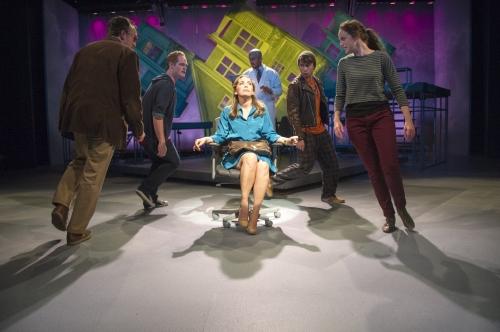A family of four prepares for just another day at school and work — until suddenly the mother is on the floor having an anxiety attack.
“Next to Normal,” the Pulitzer Prize- and Tony Award-winning musical playing at the Hangar Theatre, is a breathtaking and turbulent portrait of a family that hasn’t had a normal day in years.
Diana Goodman (Andréa Burns), a middle-aged woman suffering from bipolar disorder, anxiety and depression, has to juggle being a mother and dealing with her condition. The past two decades of her life have been a constant cycle of recoveries and subsequent breakdowns, though her husband Dan (Chris Hoch) supports her unfailingly. Because of her illnesses, her daughter Natalie (Alison McCartan) thinks Diana deprived her of a regular childhood and familial relationships. There’s also the matter of Diana’s 18-year-old son Gabe (Noah Plomgren), whom Diana loves dearly and can’t seem to let go of his mother.
Through poetic lyrics and a powerhouse score, composer Tom Kitt and lyricist Brian Yorkey explore the dangerous intricacies of the Goodman family. Both the story and its staging moved in and out of reality, allowing the audience to decide which hallucinations were actually effects of Diana’s illness.
Burns shined as Diana by superbly displaying her pain and hope, sometimes using only her facial expressions. Her singing also captured the spirit of this resilient character. Yet, for most of the play, she seemed like she wasn’t allowing herself to embrace Diana’s bipolar emotions. This character choice was perhaps meant to exemplify Diana’s desire for normalcy versus healing, but on stage she simply came off as indecisive.
Meanwhile, Hoch was able to fully change his character from unconditionally supportive to shattered within a few minutes, never seeming rushed or unrealistic. He found the balance between Dan’s admirable and mysterious sides while showing off his vast vocal range in songs like “I Am the One” and “Better Than Before.”
Gabe has little interaction with his family and even less background, yet Plomgren had a strong stage presence and defined physicality. Despite his challenging role, he electrified the audience, especially in his commanding solo “I’m Alive.”
Natalie and her romantic interest Henry (Adam Fontana) created the plotline of the show. They each excelled in their portrayals of two often-stereotyped archetypes of modern teenagers. McCartan played the overachieving, troubled teenager hoping to escape her home life, and she effectively made the audience understand Natalie’s fear of ending up like her mother. Fontana stunned the audience as well, as a likable and determined stoner, complementing McCartan well. The captivating evolution of their relationship is mainly because of their magnificent onstage chemistry.
The backdrop, consisting of upside-down house cutouts suspended in midair, enhanced the entropic mood of a story set in a traditional suburban neighborhood. The unit set of platforms, stairs and tables — which represented the family’s home — was efficient, with smooth entrances and exits. However, its bare and undistinguished feel made the house setting appear more clinical than domestic, alienating audience members trying to connect to this family’s surroundings.
Nonetheless, director Tracy Brigden’s staging succeeded despite the set’s minimalism. Her clever directing wove throughout the show seamlessly, allowing the actors to pursue the script’s thought-provoking scenes effortlessly.
The choreography functioned as much-needed comic relief. Often, the use of the uninvolved characters in the scene as a humorous dance chorus offered an ironically happier feel to a rather depressing subject matter. She utilized the entire space well, including the downstage area, establishing clear locations in the audience’s mind despite the scarce set.
Michael Krass’s costume design was appropriate and charming, particularly for Henry and Natalie’s spring formal outfits — Henry dressed in an old-timey tuxedo and Natalie in a classy blue dress. However, some choices were odd, such as Diana’s costumes and make-up, which seemed unrealistic and too glamorous for a woman struggling with such a severe illness.
Grief, psychiatry and suicide are only a few of the conflicts in this amazing rollercoaster drama, which plays just under two and a half hours. Though the Goodmans try to maintain a normal family life, the Hangar proves crazy might be better than normal.





